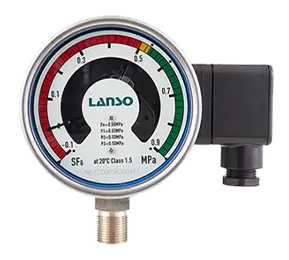Correct installation of pressure instrument equipment:
To perform pressure detection, and a measurement system is actually needed to achieve it. To achieve accurate measurement, in addition to the correct selection and verification (calibration) of the instrument, attention must be paid to the correct installation of the entire system. If only the pressure gauge itself is accurate, its indication cannot fully represent the actual parameters of the measured medium, because the error of the measurement system is not equal to the error of the instrument.
The correct installation of the system includes the opening position of the pressure tap, the reasonable laying of the connecting pipe and the correct installation position of the instrument.
1. Selection of the position of the pressure tap
(1) Avoid being in the area where the pipeline is bent, bifurcated and the stream forms vortex.
(2) When there is a protruding object (such as a temperature measuring element) in the pipeline, the pressure tap should be taken in front of it.
(3) When pressure must be taken near the regulating valve, if the pressure tap is in front, the distance from the valve should not be less than 2 times the pipe diameter; if the pressure tap is behind, the distance from the valve should not be less than 3 times of the pipe diameter.
(4) For a wide container, the pressure tap should be in an area where the fluid flows smoothly and there is no vortex. In short, the position of the pressure tap determined in the process flow should be able to ensure that the selected process parameters are measured.
2. Lay out of connection pipes
The horizontal section of the connecting pipe should have a certain slope to facilitate the removal of condensed liquid or gas.
When the measured medium is gas, the pipe should be tilted towards the pressure tap. When the measured medium is a liquid, the pipe should be tilted towards the pressure measuring instrument; when the measured parameter is a smaller differential pressure value, the degree can be slightly larger. In addition, if the duct is turning up and down, according to the medium in the duct, a device for draining condensed liquid should be installed at the lowest point or an exhaust device at the highest point to ensure that condensation does not accumulate in the duct for a long time to affect the accuracy of the measurement. As a result, the condensed liquid or gas should be discharged regularly.
General notes about pressure instrument equipment installation
Under normal circumstances, the installation height should be flush with people's line of sight, about 1.5m. For high-pressure gauges, the installation height should be higher than the average person's head.
When measuring the pressure of liquid or steam medium, the error caused by the liquid column should be avoided. The pressure measurement tool should be installed at the same level as the pressure tap, otherwise the indication value of the pressure gauge must be corrected.
For the connection of the pressure gauge, select an appropriate material as the sealing gasket according to the measured pressure and the nature of the measured medium to prevent leakage.
The thickness of the pressure guiding tube should be suitable, generally 6-10mm, and the length is as short as possible, otherwise it will cause measurement delay.
The pressure meter should be installed at room temperature as much as possible, and the relative humidity is less than 80%, with small vibration, less dust, and no corrosive substance. For the electrical pressure meter, electromagnetic interference should be avoided as much as possible.
When two pressure gauges are installed side by side, the distance between the instrument shells should be 0-50mm.
The installation position of the pressure gauge should be avoided where there are frequent mechanical operations, so as not to damage the measuring instruments for pressure when operating other equipment, such as manually operated valve handle.
Special media installation of pressure instrument
When measuring the pressure of high temperature (above 60℃) fluid medium, in order to prevent the direct contact between the heat medium and the elastic element, a U-shaped tube or coiled tube should be installed before the pressure meter to avoid the influence of temperature changes on the measurement accuracy and elasticity of the component.







